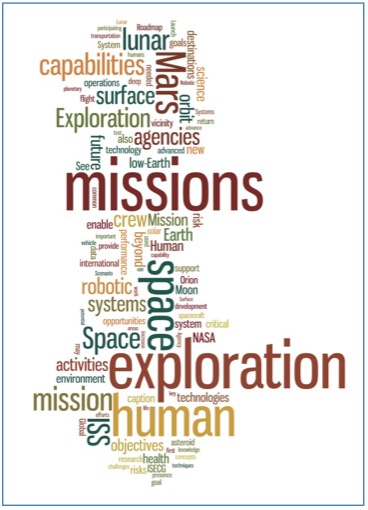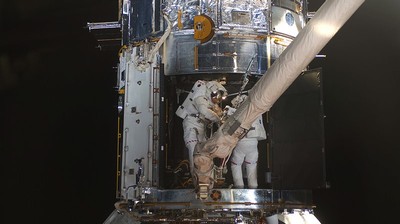The astronomical community must wake up: the need for synergies between science and explorationby Matt Greenhouse
|
 Figure 1: A word cloud diagram of the Global Exploration Roadmap. Font size is proportional to the number of occurrences of the most frequent 100 words in the document. The word “astrophysics” appears only once in this document and hence, is not apparent in the diagram. Finding the word “science” is left as an exercise for the reader. |
When the major mission objectives of the Human Exploration and Operations Mission Directorate (HEOMD) and the Science Mission Directorate (SMD) are orthogonal to each other, yardage gained per dollar spent on moving the ball down field toward meeting mission objectives is a minimum. In an environment of persistent downward budget pressure, we cannot afford the loss of synergy that once existed during the Hubble era between human spaceflight and achievement of major science objectives.
Science is the primary method by which meaningful exploration is conducted. The Hubble Space Telescope mission architecture has yielded humanity’s most successful exploration of our universe. This success was entirely enabled by the human servicing aspect of the Hubble mission architecture. However, the synergy between the above directorates that made the stunning achievement of the Hubble possible is no longer apparent today, and is largely absent in the above roadmapped vision for the future of human spaceflight.
| The Hubble Space Telescope mission architecture has yielded humanity’s most successful exploration of our universe. This success was entirely enabled by the human servicing aspect of the Hubble mission architecture. |
Exploration mission architectures that follow a “use once throw away” approach to multibillion-dollar assets, such as the JWST, do not enable a sustainable future for the US space science community. Deep-space astrophysics mission architectures involving low delta-V space vehicle return to a stable Earth-Moon Lagrange point for human-assisted robotic servicing is both practical and consistent with currently planned GER assets such as the Space Launch System (SLS), Orion Crew Exploration Vehicle, solar electric propulsion, and deep-space habitats. Although human servicing of deep-space robotic science missions provides a near-term context in which these assets can be developed in a way that yields immediate value to the nation’s science community, this approach is not a central element of the GER plan or the current national space policy.
National space policy is not made by NASA. It is set by the White House Office of Science and Technology Policy (OSTP), and adjustments to it often accompany changes in the Administration. Despite the ongoing budget challenges facing the Nation, the SLS is expected to fly during this decade. The train of the human space flight program will leave the station. However, the astrophysics community car is not coupled to it, and its occupants appear so focused on internal community advocacy for one narrow specialty or another, they have failed to notice that their car is being left on a siding with no sustainable future. As the Nation approaches the next potential course correction for OSTP direction on human space flight, the science community must speak with unanimity of opinion that realization of National Academy of Sciences objectives for major initiatives in space science must be among the top priorities for the Nation’s human space flight program and the National space policy.
During 2008, the National Academy of Sciences Space Studies Board released its report on scientific use of Constellation Program assets, particularly the Ares V rocket (similar in capability to the SLS.) They found that astrophysics was among the most practical scientific applications for that program’s assets. That finding applies to today’s Exploration Program assets. However, absent a correction to the course plotted by the GER that would steer toward deep-space (Earth-Moon Lagrange point) human-assisted servicing of robotic science mission space vehicles, neither HEOMD nor SMD can realize development of the major initiatives that the nation needs. The US astronomy community must wake up and strongly advocate for their stake in the future direction of human spaceflight.
As a consequence of the finite speed of light, telescopes are tools that allow astronomers to see into the past. However, as a community, we often lack ability to focus on seeing into our own future. The 2012 National Research Council report on strategic direction for NASA suggests that now would be a good time for our community to begin strong, consistent, and persistent advocacy that reminds future administration policymakers of how the earlier synergy between NASA’s human spaceflight and space astrophysics programs gave this Nation the Hubble Space Telescope—its most far reaching achievement in space since Apollo.
| A national space policy that synergizes human and robotic exploration via creation of science missions in a deep-space serviced architecture is the best way to rekindle the mission success of the Hubble and Apollo programs with the cost effectiveness required by today’s stakeholders. |
A human spaceflight program that leverages development of deep-space operational capability for human exploration of Mars in the long term, with cislunar space human servicing of robotic science missions in the near-term, is the most cost-efficient way forward. A teamwork approach in which HEOMD is responsible for development of the servicing mission architecture involving an Earth-Moon Lagrange point depot, and SMD is responsible for science mission selection and implementation, yields an internal partnership with clear roles, responsibilities, and interfaces. The Hubble-like science value that this approach would return in the near-term will attract strong international partnerships for development of both the human servicing and robotic exploration aspects.
A national space policy that synergizes human and robotic exploration via creation of National Academy of Sciences-endorsed science missions in a deep-space serviced architecture is the best way to rekindle the mission success of the Hubble and Apollo programs with the cost effectiveness required by today’s stakeholders. Deep-space servicing is the mortar that can bind the bricks of a “One NASA” that extends the legacy of Hubble and Apollo achievements to Mars in a cost-constrained environment while returning direct scientific discovery value in the near term and at each subsequent step. We have achieved this synergy in the past. We can achieve it again if, and only if, the astronomical community strongly advocates for their stake in human space flight.
